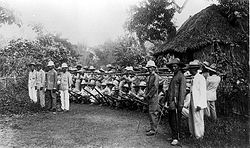List of Philippine insurrection campaigns
| Philippine–American War | |||||||||
|---|---|---|---|---|---|---|---|---|---|
 Filipino soldiers outside Manila 1899 |
|||||||||
|
|||||||||
| Belligerents | |||||||||
|
|
Republic of Negros |
||||||||
| Commanders and leaders | |||||||||
|
|
|
||||||||
| Strength | |||||||||
|
≈126,000 total |
100,000–1,200,000 | ||||||||
| Casualties and losses | |||||||||
|
|
≈12,000–20,000 killed | ||||||||
| Filipino civilian dead: ≈200,000 to 1,500,000 | |||||||||
![]() United States
United States![]() Philippine Constabulary
Philippine Constabulary
Macabebe Scouts
≈126,000 total
![]() 4,165 killed (about 75% from disease), ≈3,000 wounded;
4,165 killed (about 75% from disease), ≈3,000 wounded;
During the Philippine–American War between 1899 and 1902, the United States Army conducted nine military campaigns. Two additional campaigns were conducted after the official end to the war on July 4, 1902 in connection with the Moro rebellion, which continued until 1913. Some other significant actions occurred outside of organized campaigns, both during the war itself and in the post-war period.
...
Wikipedia
